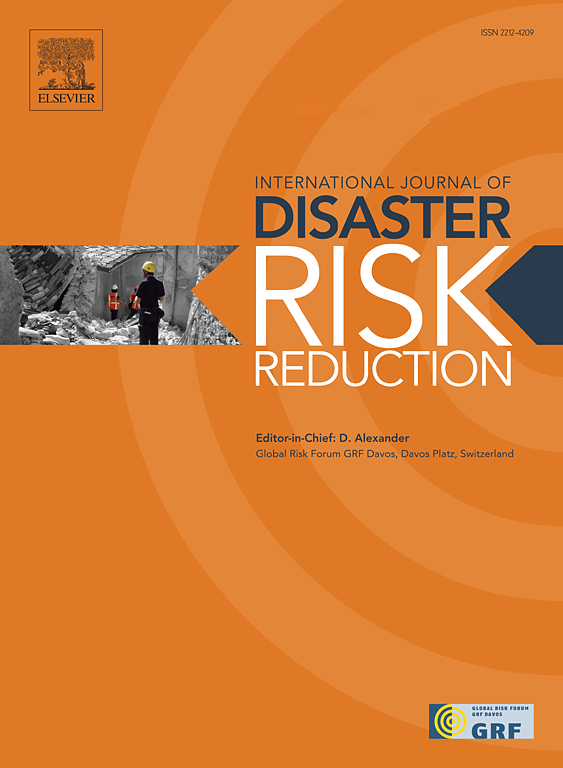城市防洪服务供需关系评价及功能区绿色基础设施优先实施区域确定
IF 4.2
1区 地球科学
Q1 GEOSCIENCES, MULTIDISCIPLINARY
International journal of disaster risk reduction
Pub Date : 2025-06-09
DOI:10.1016/j.ijdrr.2025.105640
引用次数: 0
摘要
平衡城市生态系统中防洪服务的供需关系对城市洪水管理至关重要。但对城市功能区FRS供需关系关注较少,气候变化情景下城市FRS的未来变化尚不明确。本研究分析了FRS供需关系,并在城市功能区尺度上确定了绿色基础设施实施的优先区域。结果表明,研究区FRS供应不足面积占研究区的36.1%。FRS供需匹配度主要分布在剩余区(高供给、低需求)。商业区域和住宅区域具有FRS亏缺区(低供给、高需求)的单位数量最多,而绿地区域具有FRS盈余区的单位数量最多。在气候变化情景下,从10年到100年风暴事件,FRS供应呈下降趋势(SSP2-4.5和SSP5-8.5情景分别为0.28 ~ 0.21、0.26 ~ 0.22);气候变化引起的平均FRS供需比值的变化随着回归期的增加而增加(在SSP2-4.5和SSP5-8.5情景下分别从- 0.69%增加到- 4.36%和- 1.48%增加到2.55%)。位于绿色基础设施实施高优先级的居住区单元面积占比为51.8%,位于高优先级的商业区单元面积占比为38.4%。研究结果可以促进对城市地区FRS供需关系的理解,并为城市防洪提供潜在的启示。本文章由计算机程序翻译,如有差异,请以英文原文为准。
Evaluating supply and demand relationship of urban flood regulation service and identifying priority areas for green infrastructure implementation in urban functional zones
Balancing the supply and demand of flood regulation services (FRS) in urban ecosystems is crucial for urban flood management. However, FRS supply-demand relationship in urban functional zone is less concerned, and future changes for urban FRS under climate change scenarios remain unclear. This study analyzed the relationships of FRS supply-demand and identified priority areas for green infrastructure implementation at the urban functional zone scale. Results showed the deficient area of FRS supply totally occupies 36.1 % of the study area. FRS supply-demand matching degree was mainly distributed in the surplus zone (high supply, low demand). Commercial zone and residential zone have the highest number of units with the FRS deficit zone (low supply, high demand), while green space zone have the highest number of units with the FRS surplus zone. Under the climate change scenarios, FRS supply showed a declining trend from 10-year to 100-year storm events (0.28–0.21, 0.26–0.22 for the SSP2-4.5 and SSP5-8.5 scenarios, respectively); while the changes in the averaged FRS supply-demand ratio values caused by climate change increased as the return period increased (from −0.69 % to −4.36 % and from −1.48 % to 2.55 % under the SSP2-4.5 and SSP5-8.5 scenarios, respectively). The area proportion of residential zone units located in the high priority level for green infrastructure implementation was 51.8 %, and the area of commercial zone units located in the high priority areas accounts for 38.4 %. These results could promote understanding FRS supply-demand relationship in urban areas, and provide potential implications for urban flood mitigation measures.
求助全文
通过发布文献求助,成功后即可免费获取论文全文。
去求助
来源期刊

International journal of disaster risk reduction
GEOSCIENCES, MULTIDISCIPLINARYMETEOROLOGY-METEOROLOGY & ATMOSPHERIC SCIENCES
CiteScore
8.70
自引率
18.00%
发文量
688
审稿时长
79 days
期刊介绍:
The International Journal of Disaster Risk Reduction (IJDRR) is the journal for researchers, policymakers and practitioners across diverse disciplines: earth sciences and their implications; environmental sciences; engineering; urban studies; geography; and the social sciences. IJDRR publishes fundamental and applied research, critical reviews, policy papers and case studies with a particular focus on multi-disciplinary research that aims to reduce the impact of natural, technological, social and intentional disasters. IJDRR stimulates exchange of ideas and knowledge transfer on disaster research, mitigation, adaptation, prevention and risk reduction at all geographical scales: local, national and international.
Key topics:-
-multifaceted disaster and cascading disasters
-the development of disaster risk reduction strategies and techniques
-discussion and development of effective warning and educational systems for risk management at all levels
-disasters associated with climate change
-vulnerability analysis and vulnerability trends
-emerging risks
-resilience against disasters.
The journal particularly encourages papers that approach risk from a multi-disciplinary perspective.
 求助内容:
求助内容: 应助结果提醒方式:
应助结果提醒方式:


